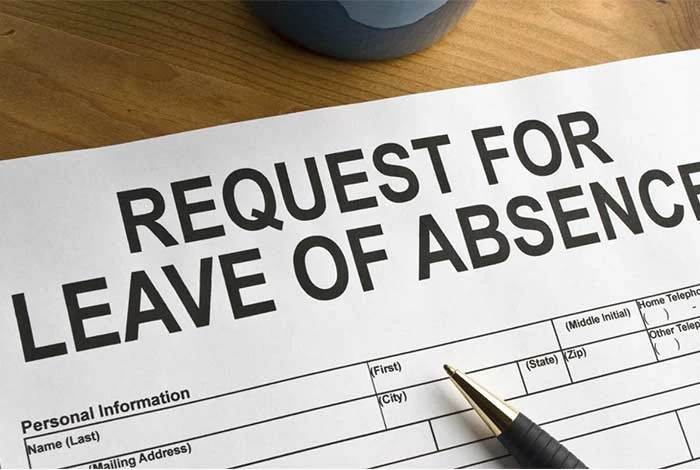Employee Leave of Absence: Policy, Rules & Impact (with Practical Solutions)

No business is immune from the possibility of an employee going on a leave of absence, generally for an extended period. A leave of absence is in a sense much more problematic than attrition, as companies can’t hire replacements for those employees.
It is crucial that companies manage their leave of absence policy cautiously and in compliance with existing laws. A flawed or undefined absence leave policy could lead to operational inefficiencies, higher employee attrition, overstaffing, or understaffing.

There are many things that companies can do to efficiently plan and manage employee absences. This article aims to talk about all the major reasons for employees’ leave of absence. Finally, we will also inform you how you should draft your leave of absence policy for a smooth procedure and to reduce its impact on business operations.
Before we get into the problem and solution statement, let’s understand more about uncertain employee leave of absence and how it’s different from other types of leaves.
What is a Leave of Absence?
A leave of absence is an approved break away from work, relatively for a longer period that employees take because of some extraordinary circumstances. Unlike other types of employee absences, such as vacation, PTO, or sick days it is generally unprecedented and is mostly unpaid or partially paid. However, in some cases leave of absence is known in advance and could be paid depending on the circumstances and nature of the employment like a sabbatical leave.

Also, leave of absence can be either voluntary or involuntary. Voluntary leaves of absence are typically taken for personal reasons, such as to take care of parents or to take a long-planned sabbatical. Involuntary leaves of absence are those imposed by employers, usually the result of unforeseen circumstances, such as ongoing investigation or a disciplinary action.
How Does Leave of Absence Works?

The absence leave process is slightly different than other leaves like PTO’s as they mostly need manual review. Every organization has their policies and processes to regulate employee’s leaves of absence.
- Request for off time: The first step is generally for the employee to request a leave of absence from their employer. This is generally done through mail or the Leave Management System (LMS), depending on the company’s policy. The request must include the dates and reason for the proposed leave request.
- Manager/HR’s Approval: Once the request is received, the employer will typically approve or deny the leave based on circumstances, policy, employee history. They may also consider whether they have sufficient staffing to cover the absent employees’ duties or not.
- On Approval: If approved, the employer will work with the employee to determine how best to cover their duties while they are away. This may involve reassigning tasks to other employees, hiring a temporary worker, or simply managing without someone in that role until the employee returns.
- On Denial: If denied, the employer will usually provide a reason for their decision and offer alternatives if possible. For instance, they may suggest that the employee can take work from home instead or stagger their days off. This will ensure that they can still have some time away from work without disrupting business operations too much.
- Pay During Leave of Absence: Whether an employee is paid during their leave of absence generally depends entirely on the company’s policy. Employers may also consider other circumstances, employee’s history, designation, importance and the impact of the employee.
- Communication: Once everything is finalized, it is important to communicate these plans to all parties involved. These include managers, co-workers, and customers who may be impacted by the change in staffing. It ensures that every member of the team knows the upcoming constraints and can take a proactive approach to minimize disruptions.
Types of Leave of Absence
There are several different types of leave of absence, each with different causes and impacts. Here is a brief overview of the most common types of leave:
- Medical Complications: While most companies offer sick days off to every employee, serious medical conditions, chronic diseases, and long-term complications are not accounted for by organizations. The employee could be unable to work or decide to take days off for a longer period either for their own medical conditions or to take care of someone in their family.
- Sabbaticals: Sabbaticals are usually taken for personal or professional development opportunities such as study abroad programs, research projects, or internships. Sabbaticals are generally partially paid but can be paid or unpaid, depending on the company policy, work history, and agreement.
- Maternity/Paternity Leave: Maternity leave is mandatory for every organization and it could last from anywhere between 6-16 weeks with pay. Most companies also offer some form of paid paternity leave to allow male employees to bond with their children.
- Bereavement Leave: In the event of a death in the family, many employers will offer bereavement leave to allow employees time to grieve and plan.
- Mental Health Leave: Sometimes employees need some time off work for sound mental health and well-being. This type of leave of absence can be voluntary and involuntary and could be for a variety of reasons such as anxiety, depression, burnout, or trauma.
There could be many other reasons for a leave of absence like Jury Duty, Military duty, or Community service depending on the country or state your organization operates in.
The Impact of Leaves of Absence on Businesses

Unprecedent leaves could leave both negative and positive impact on your business. Here are some of the main effects of absence leave on business:
- Operational: Depending on the type and duration of the leave, businesses may have to adjust their operations to accommodate the employee. This could include hiring a temporary replacement, reassigning tasks to other employees, or making changes to processes or schedules.
- Financial: If an employee is paid during their leave, this could put a strain on the company’s budget. Alternatively, if an employee is not paid during their leave, they may fall behind on bills or be unable to meet their personal financial obligation.
- Reputation: In some cases, leaves of absence can also impact the reputation of businesses. For example, if an employee takes sabbatical for personal development opportunities, this could reflect positively on the business and improve its reputation.
How to Create a Leave of Absence Request Policy for Employees?

The leave of absence request policy will vary from business to business depending on the organization’s needs and resources. Here are some key elements that must be considered while drafting a leave of absence request policy, such as:
- Purpose and type of leaves
The purpose of the leave of absence request policy should be clearly stated so that employees know what the policy covers and why it exists. It should cover both foreseen and unforeseen circumstances that might occur in an employee’s life.
Generally, most companies allow a leave of absence for medical complications, bereavement, sabbatical, and maternity/paternity.
- Eligibility
The eligibility criteria for taking a leave of absence should be outlined in the policy so that employees know who can and cannot take advantage of the benefit. This could include length of service, job role, and performance. However, most companies allow managerial staff to take a sabbatical after 5 years of service.
- Procedure
The procedure for requesting a leave of absence should be clearly laid out so that employees know how to go about it. This could involve submitting a form or emailing HR with the relevant information. It is also important to note the timeframe in which employees need to submit their requests based on the nature of leave.
Maternity/ paternity leave request generally needs to be submitted 1-2 month before while other unforeseen circumstances are generally submitted on the day itself. Similarly, sabbatical needs to be informed as early as possible, generally 3-6 months ahead of the leave.
- Duration
The duration for which the leave of absence is granted should also be stipulated in the policy. This is important so that employees know how long they can be away from work and plan accordingly.
Generally, a medical leave of absence may only be granted for a period of 6-12 weeks. Other leaves like maternity/ paternity leaves could range from 9-18 weeks while a sabbatical may be granted for up to 1 year.
- Compensation
The policy should also state whether employees will be paid during their leave of absence. There could also be conditional and partially paid leave depending on the agreement with the employee.
Most companies pay employees during maternity/paternity leave, but some may offer partial compensation. Companies may even sign bonds with employees before agreeing to paid Sabbatical leave, making sure that the employee works for a certain period even after completing his studies.
- Guidelines
Guidelines around leaves of absence should also be included in the policy. This could cover things like whether employees need to keep in touch with the company during their leave. Or if they are permitted to work for other organizations during their leave, and whether they are required to repay any money received from the company during their leave.
Include these key elements in your leave of absence request policy to ensure that both employers and employees are aware of their rights and responsibilities when it comes to taking time off work.
Ways to Minimize the Impact of Leave of Absence in Business Operations

Absenteeism could lead to chaos in the well-established order of business. Especially in small business and senior management positions, extended leave could significantly impact the operations of a company. Every organization must have a contingency plan to cover the leave of absence of an employee.
There are a few key ways that businesses can minimize the impact of leave of absence on their operations.
- Planning in Advance
If you know that an employee will be taking a leave of absence, try to plan for it in advance so that you can have someone else cover their duties while they are away. This could involve training another staff member to do the job, hiring a temporary replacement, or rearranging work schedules so that other employees can pick up the slack.
- Compensate in Exchange for Guidance
Another way to minimize the impact of a leave of absence is to make sure that employees are adequately compensated and be in touch for their time away from work. This could involve paying them their full or partial salary in return for managing and guiding subordinates during their time away.
- Build Multi-Functional Team
Organizations must build teams with every member able to perform multiple roles. Other members of the team must be able to cover for the absent employees.
For example, if you have a sales team, there should be someone on the team who can manage customer service inquiries if the customer representative is not available.
How Can Leave Management Software Help?
Leaves of absence affect the operations of companies across all industries. It’s important to take a proactive approach to manage them. One way to manage leaves of absence in an organized manner is through software.
Employee Leave Management Software (ELMS) lets you set policies, send out reminders, track attendance, and manage the leave process with ease. ELMS can help you avoid the problems of absenteeism by tracking absences, ensuring that employees receive leave benefits, and providing the ability to send notifications to management about an employee’s absence.
Conclusion
Leave of absence isn’t rare, every organization goes through this. Businesses need to have an efficient and reasonable absence leave policy to manage employee absences and ensure that business operations are impacted minimally. Employees must take a proactive approach to counter these uncertain leaves and prepare contingency plans.
FAQs
How long can you take a leave of absence from work?
The duration of leave that you can take depends entirely on company policy, circumstances, and work history. Some companies may allow for longer leaves of absence, while others may have shorter limits depending on the circumstances. It is essential to cross check with your organization’s HR department for detailed information.
What is the best reason to take leave?
The reason to take leave depends on your situation. However, some common reasons for taking a leave of absence include maternity or paternity leave, personal or family illness, and sabbatical. It is important that you communicate the genuine reason to your HR and manager.
How to Apply for Leave of Absence from Work?
Some employers may have a formal process that you need to follow, like applying through the Leave management System (LMS). While others may be more relaxed, and simple mail communication with all details could do the job.
What does it mean to take a leave of absence from work?
A leave of absence from work is a period that an employee takes off from their job due to some extra ordinary reason other than normal sick days, vacation, and PTOs.
Can an employer refuse to give you unpaid leave?
Yes, under some extreme circumstances, employers can refuse to give unpaid leave. However, these only happen when the reason for absence is unacceptable, or the employee's job role/history doesn’t make him/her/them eligible for unpaid leave.
What is the difference between leave without pay and leave of absence?
Leaves of absence can be either paid or unpaid, depending on the company policy and the reason for the leave and it is generally for an extended period. Leave without pay is a leave that an employee avails of either after exhausting regular earned PTOs or for not taking prior approval and is generally for short period.
Can Leaves of Absence be Extended?
Yes, under some circumstances, a leave of absence can be extended. For example, if an employee is on maternity leave and they need more time off to recover from childbirth or bond with their baby, they may be able to extend their leave. However, this will depend on the company's policy and the reason for the original leave.
Am I required to continue paying salary when employees are on FMLA leave?
In the US, The Family and Medical Leave Act (FMLA) is a law that says organizations need to provide employees at least up to 12 weeks job-protected leave per year which could be unpaid. Employers are required to pay employees' salaries if the employee has remaining earned leaves, and they wish to avail it.
Related Categories: Employee Payroll Management System | Human Resource Management Tools | Employee Attendance Management System | Applicant Tracking Software
Rajan is pursuing CA with a keen interest in trends and technologies for taxation, payroll compliances, Tally Accounting, and financial nuances. He is an expert in FinTech solutions and loves writing about the vast scope of this field and how it can transform the way individuals and businesses... Read more






















